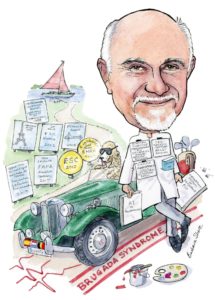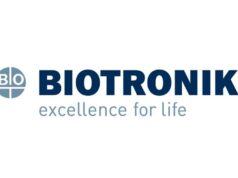
With his brothers Josep and Ramon, Pedro Brugada discovered the syndrome that bears their name. He reflects on his career highlights with Cardiac Rhythm News, charting the development of electrophysiology from esoteric to mainstream therapy, and stresses the role that maintaining curiosity plays in driving progress.
Why did you decide to become a doctor and why, in particular, did you decide to specialise in electrophysiology?
I became a doctor by chance. As the son of farmers, I would have loved to have taken over my parents work, but my mother was completely against it. So I chose the art academy, but my mother was against that too, as she was when I suggested a music conservatorium.
Instead, she sent me to the University of Barcelona. As I did not know what I wanted to do, I registered for first-year medical school and first-year philosophy. I achieved 100% in all medical subjects in my first-year exams, so I decided to continue studying medicine.
As a student, I had the opportunity to work all day (and night) at the hospital. I spent a lot of time in the haematology laboratory, and I wanted to become a haematologist. However, my mentor, Professor Rozman, discovered that I was too young to start and wanted me to wait for a year. My first daughter was due and I needed a job. There was a position free in cardiology—and that is how I became cardiologist.
I finished my cardiology training at the age of 26 years. My education at the University of Barcelona under the guidance of Professor Paco Navaroo was superb. But not much was known about cardiac arrhythmias, and Professor Hein Wellens had just moved to Maastricht’s new university. He accepted me as a fellow—believing that I had a grant that I had not in fact received—and I moved to Maastricht for a six-month fellowship. I never went back to Spain.
Who have been your career mentors?
At college, Professors Erundino Sanz and Josep Brugulat. At medical school, Professors Cirilo Rozman. During my cardiology training, Professor Paco Navarro, and Drs Gines Sanz and Amadeo Betriu. In electrophysiology, Professor Hein Wellens. But there have been other important people—Joan de Palau for arts, Josep Torrent for languages, Albert Stofberg for athletics and swimming, and my friends in my village, Banyoles, for music.
What has been the most important development in the field of electrophysiology during your career?
There have been many. It is difficult to choose. I have seen electrophysiology move from an esoteric field reserved for “crazy” minds to a subspecialty capable of curing practically any cardiac arrhythmia. Single chamber pacemakers evolved into DDD pacemakers, and into resynchronisation devices, and the implantable cardioverter defibrillator (ICD) became a reality during my early career as an electrophysiologist. Ablation and cardiac resynchronisation therapy (CRT) devices are probably the greatest contributions that electrophysiology has made to clinical medicine. Recently, the full entry of genetics into rhythmology has been another milestone.
What is the biggest challenge facing electrophysiology?
The biggest challenge is to correctly implement current knowledge. There are still many patients with cardiac arrhythmias who do not benefit from modern technologies because there is no correct diagnosis, or because the treating physician is unaware of the possibilities. Electrophysiologists should come down to earth and educate general practitioners and general cardiologists about the therapies that are available for cardiac arrhythmias.
What has been your biggest disappointment? Something, you hoped would change practice but did not?
I developed a technique for ablation of cardiac arrhythmias using intracoronary ethanol. This technique is still sometimes used, but it was completely overtaken by radiofrequency ablation. Although my technique did not become standard practice, it was a first step towards a cure for cardiac arrhythmia, so in that sense I am not disappointed. And I will never forget the editorial by Doug Zipes, entitled “Targeted therapy”, which accompanied my publication in Circulation on “Transcoronary chemical ablation of ventricular tachycardia”.
Of the research you have been involved with, what do you think will have the greatest impact on clinical practice?
Without any doubt, the publications on Brugada syndrome.
What are your current research interests?
Brugada syndrome remains my main research interest, but I am also still fascinated by classic electrophysiology mechanisms. Recent interests of mine also include the application of artificial intelligence in rhythmology, and the circulatory system of the drosophila fly. And, in addition, all applications of hybrid surgery in the treatment of cardiac arrhythmias.
What do you consider to be the most important paper published on this topic during the past year?
The most important paper on Brugada syndrome was the risk score by Dr Sieira that was published in the European Heart Journal; and Papadakis’ paper, published in JACC, on family screening after sudden death of unknown cause was also valuable.
What are the key priorities for future research in this area?
We need serious randomised studies on the value of catheter ablation in Brugada syndrome. And in relation to hybrid therapy of cardiac arrhythmias, we need to train more cardiac surgeons to work with electrophysiologists.
How has the management of arrhythmias moved on from when you first described Brugada syndrome?
The developments have been very rapid and excellent. But we have also seen some disappointments. Quinidine seems of no value in Brugada syndrome. Ablation is promising, but we need randomised studies and these are almost impossible to perform. ICDs have proven to be effective and safe—when the risk–benefit ratios are carefully considered. We regularly performed pre-implant genetic diagnosis after in vitro fertilisation in couples where the genetic defect is known. This technology should spread rapidly in the future, to eliminate transmission of the disease.
What is the role of e-medicine in monitoring patients with chronic heart disease?
The role of e-medicine is underestimated. It is the best protection that one can offer to patients. They should be actively involved in their follow-up through thoughtful understanding of the technology. Monitoring should be bidirectional—it should allow physicians to contact and changes device parameters through the internet. A 24/7 monitoring unit should be present in each centre involved with these types of patients.
Social media platforms such as Twitter and LinkedIn are increasingly being used as a source of medical communication. What are the pros and cons of using social media for medical communication?
I believe that their role will continue to increase in a positive way. However, this will only be feasible with full medical control. Amateur sites should be forbidden, and university hospitals should take full control of the technology. Patient forums should be actively directed and corrected by medical institutions.
What has been your most memorable case?
Without any doubt my most memorable case is Lech, the first patient with the condition that would later become known as Brugada syndrome. He is in my thoughts every morning when I wake up, and every night when I go to bed. I regret his death every day.
What advice would you give to someone who was starting out in cardiovascular medicine?
Be curious. Search out and remain only with mentors that share your curiosity. Curiosity is the basis for any scientific progress.
Outside of medicine, what are your hobbies and interests?
There are many. My hobbies are painting, music, and classic cars. I enjoy sports such as golf and sailing. And my interests include history.
What would you have been if you had not been a medical doctor?
It is impossible to know what I might have done. Maybe instead of a happy doctor, I would be a happy farmer.
Fact File
Current appointments
- Scientific director, Cardiovascular Division. University Hospital UZ Brussel, Brussels, Belgium
- Chief executive officer, Medisch Centrum Prof P Brugada, Aalst, Belgium
- Director, Arrhytmia Unit Hospiten, Estepona, Spain
Selected education and prior appointments
- 1969–1975: Medical School, University of Barcelona School of Medicine, Barcelona, Spain
- 1979–1980: Research fellow in Clinical Cardiac Electrophysiology, University of Limburg, Maastricht, The Netherlands
- 1980–1984: Assistant professor, Department of Cardiology, University of Limburg, Maastricht, The Netherlands
- 1982–1990: Director, Clinical Electrophysiology Laboratory, University of Limburg. Maastricht, The Netherlands
- 1988–1990: Head, Division Coronary Disease, Institute for Cardiovascular Diseases, University of Limburg, Maastricht, The Netherlands
- 2009–2011: Chair, Fellowship Committee European Heart Rhythm Association
- 2011–2016: Chair, Cardiovascular Division Universitair Ziekenhuis Brussel, VUB, Brussels, Belgium
- 2016–2017: Scientific director, Arrhythmia Unit, GVM Italy, Cotignola, Italy
Selected professional honours and awards
1999: Fritz-Acker Stiftung Award, German Society of Cardiology
2001: Cardiologist of the Year 2001, Paris, France
2003: First price at the European Society of Cardiology, Vienna, Austria
2008: Mirowski Award, San Francisco, USA
2009: Einthoven Gold Medal, European Heart Rhythm Association
2012: Gold Medal, European Society of Cardiology
2017: Honorary Lecture FAFA. Frankfurt, Germany.
2019: Grand Prix Scientifique 2019, Institut de France, Fondation Lefoulon-Delalande









